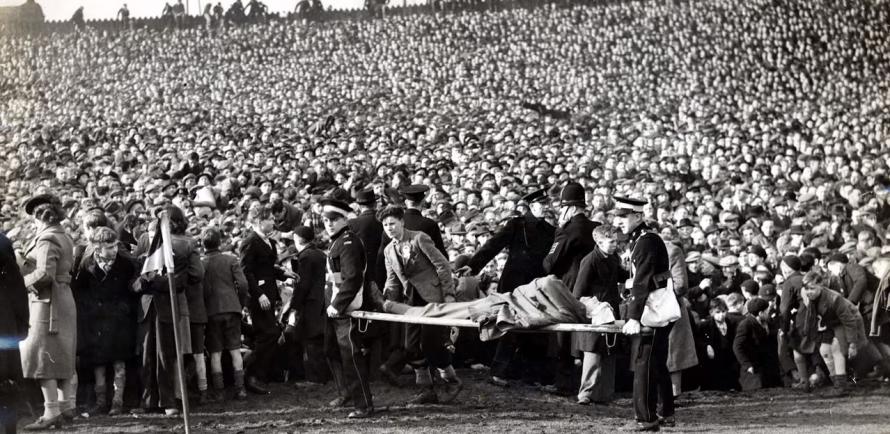Burnden Park, Bolton, circa 1946
March 9, 1946, 75 years ago: A 2nd-leg tie of the Football Association Cup Quarterfinal is played at Burnden Park, a soccer stadium in Bolton, in what is now Greater Manchester, in the North-West of England. It ends in disaster -- and not because of the game itself.
This was the 1st FA Cup tournament held after World War II, and every round from the First Round Proper to the Sixth Round (the Quarterfinal) was held over 2 legs, 1 at each team's ground. (At the time, "stadium" seemed too grand a word for many of the venues in question). In the 1st leg of this round, at the Victoria Ground in Stoke-on-Trent, Staffordshire, Bolton Wanderers beat Stoke City 2-0.
For the return fixture, a crowd estimated at 85,000 people crammed into Burnden Park, a ramshackle structure built in 1895. Unlike in American baseball, there was no building boom in English football when concrete and steel stadiums became viable early in the 20th Century. Many of the old wooden structures were still in place as the Century neared its end.
And the crowds were bigger than ever, following the suspension of Football League and FA Cup competition at the dawn of the 1939-40 season, as the British Empire entered World War II. Buildings like Burnden Park were simply not designed with that many people in mind. Indeed, the gates were closed at 2:40 PM, 20 minutes ahead of the traditional English football kickoff time, because the stadium stewards didn't think any more people could fit in.
Shortly after the 3:00 kickoff, fans started spilling out of the Railway End, the stadium's north end, onto the pitch (the field). The referee, George Dutton, stopped the game, and had the pitch cleared. But two of the standing-room barriers on the End collapsed, and the crowd fell forward, crushing those underneath.
Unaware of this occurrence, Dutton restarted the game. But a police officer came onto the pitch to tell him that a fan had died. Dutton called over the Captains, Harry Hubbick of Bolton and Neil Franklin of Stoke, told them, and the players left the pitch.
After half an hour, in which the dead and injured were carried out, the game was restarted. Stanley Matthews, the Stoke superstar known as "The Wizard of Dribble," said that he was sickened by the decision. Not surprisingly, the game had little urgency, and ended 0-0. Thus, Bolton won 2-0 on aggregate, and advanced to the Semifinals.
It was later determined that 33 people had died, with over 400 injuries. It was the worst stadium-related disaster in British history, and it remained so until the Ibrox Park disaster of 1971. It has also been surpassed by the Hillsborough Disaster of 1989.
The FA Cup Semifinals were played on March 23. Bolton went to Villa Park in Birmingham, home of Aston Villa, and were beaten 2-0 by Charlton Athletic of South-East London. At Hillsborough Stadium in Sheffield, Yorkshire, where the aforementioned 1989 disaster would occur, Birmingham City and East Midlands team Derby County played to a 1-1 draw. A replay was held on March 27 at Maine Road, home of Manchester City, and Derby won that game 4-0. The Final was played on April 27 at the original Wembley Stadium, and Derby beat Charlton 4-1 in extra time. There were no security or safety incidents at any of these games.
A benefit match for the Burnden Park victims was held on August 24, 1946, at Maine Road. The national teams of England and Scotland played to a 2-2 draw.
Following the Hillsborough Disaster of 1989, it was ruled that all British stadiums would be converted to all-seater. This doomed most of the old stadiums that hadn't already been modernized, as it became cheaper to build an entirely new stadium than to fix up and maintain the old one. Conversion to all-seater left Burnden Park with a capacity of around 25,000.
Burnden Park, near the end
In 1997, Bolton Wanderers moved to what's now known as the University of Bolton Stadium, seating capacity 28,723. Burnden Park was demolished in 1999, and an Asda supermarket is now on the site.




No comments:
Post a Comment